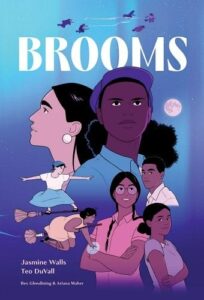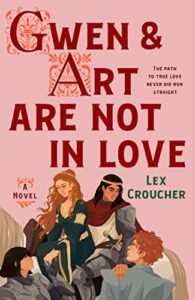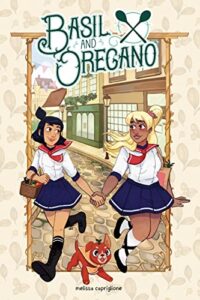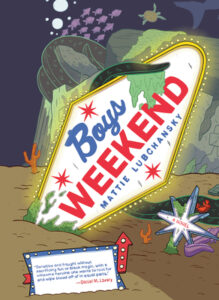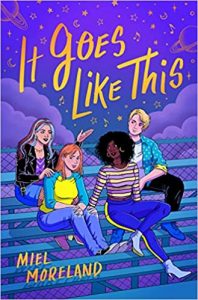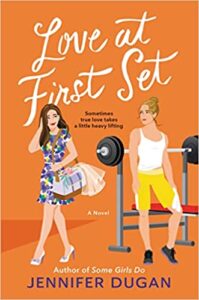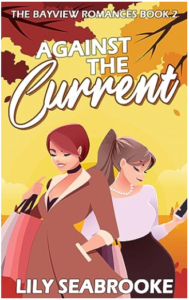Buy this from Bookshop.org to support local bookstores and the Lesbrary!
Brooms is a YA graphic novel created by Jasmine Walls (writer) and Teo DuVall (illustrator) and published in 2023 by Levine Querido. It is set in an alternate 1930s Mississippi where magic flows all around, but is heavily restricted. Only certain people are allowed to learn certain types of magic to be used only in certain situations, with offenders punished by having their magical abilities locked away. Native American children showing magical abilities are rounded up and sent to government schools where they can learn “proper magic”.
Despite the law’s best efforts, there’s one type of magical activity that continues to thrive: underground broom racing. Every weekend, teams of thrill seekers meetup to see who can take home the prize money for being the best. One such team is the Night Storms. Led by their captain Billie Mae, the team includes her best friend Loretta, Cheng Kwan, Mattie, and Emma. Together, they hope to make enough money to make their dreams come true.
The greatest strength of Brooms is its worldbuilding. The setting of a magical 1930s Mississippi feels unique as it’s not a setting that has often been explored. By emphasizing history accuracy, Jasmine Walls shines a light on the queer communities that existed at that time but have long been ignored. The diversity of characters is also phenomenal. Mattie and Emma are mixed Black and Choctaw. Luella, their cousin who introduces them to the rest of the team, is mixed Choctaw and Mexican. Cheng Kwan is transgender and Chinese American. Emma is Deaf and speaks Indian Sign Language. Billy Mae and Loretta are Black and suffer from chronic illness and disability. Billie Mae and Luella are in a relationship with one another. Other broom racing teams include characters who are nonbinary, amputees, or come from other cultural backgrounds. Through this diversity, Jasmine Walls succeeds in showcasing people who have long been underrepresented in the media, including fantasy media. It gives every queer, BIPOC, and disabled reader the chance to see themselves as a part of the magical community of Brooms.
Brooms also does a great job of developing its main characters and their relationships. The main cast is fairly large, consisting of the five racers and Luella. Through a combination of the main story and flashbacks, we get to see how this small chosen family came to be and how they continue to support each other. Luella and Billie Mae also get these really sweet moments together that show how deep their love for each other is. This made for characters and relationships that felt fully fleshed out. I was able to feel a strong connection with each and every one of them. It also made it harder for me to put the book down. I just had to know how their stories ended!
I appreciate how Jasmine Walls was able to convey an overall hopeful tone while also clearly conveying the danger the characters are facing. Throughout the novel we are shown the very imminent threat that the girls and their community are under without ever slipping into a darker tone. We see racism and oppression, but never in its full brutality. These scenes are balanced with ones that show that, despite that oppression, the characters’ spirits never falter. They continue to support each other and their community in the face of overwhelming bigotry. To me, this feels like the perfect balance to aim for in a YA graphic novel. The people most likely reading this book may be dealing with real bigotry in their daily lives; they don’t always need to see it in their books too. They need hope and, in that regard, Brooms succeeds in giving them that.
I found the story’s focus on the power of community incredibly resonant. Brooms isn’t a story about a group of people coming together to overthrow racist and bigoted power structures. Instead, it’s a story of how finding and building a supportive community can help people survive and thrive in spite of the dangers that surround them. It shows the reader that there is hope in community as long as its members stick together and look out for each other. It’s a message that we need more than ever.
Brooms is also a really pretty graphic novel. The contrast between the earthy tones of the daytime scenes and the vibrant colors of the magical night races give these events a wondrous quality. It provides a nice contrast between a world that shuns non-White magic and one in which everyone is welcome and loved. The broom races also have this dynamic quality in their rendering that helps convey a sense of speed and danger, making for a thrilling read.
In the end, I enjoyed my time with Brooms. It is a well written and beautifully illustrated story that showcases the power of hope and strength of community. Through its historical setting and diverse cast, it highlights the simple fact that queer communities have always existed and will continue to exist into the future. It’s a message that every queer person, no matter their age, needs to hear.

